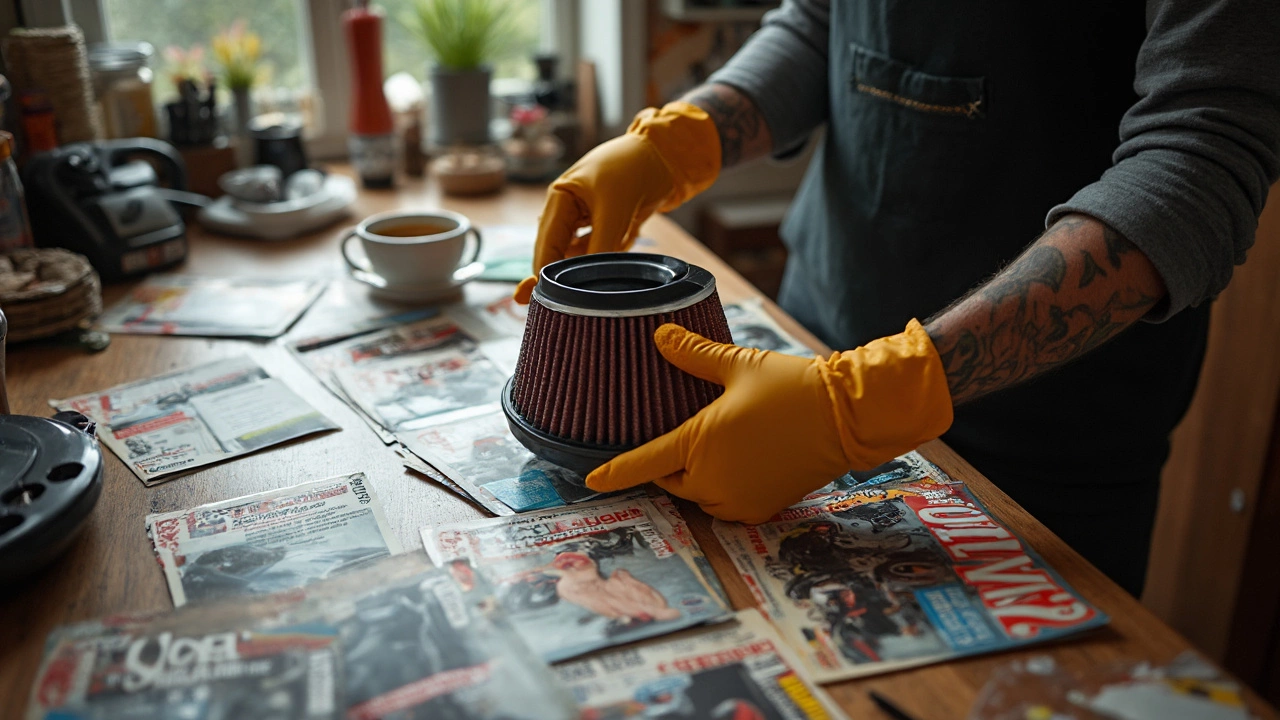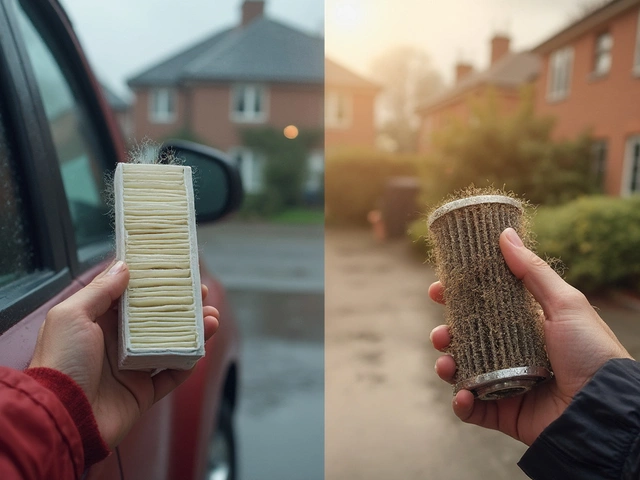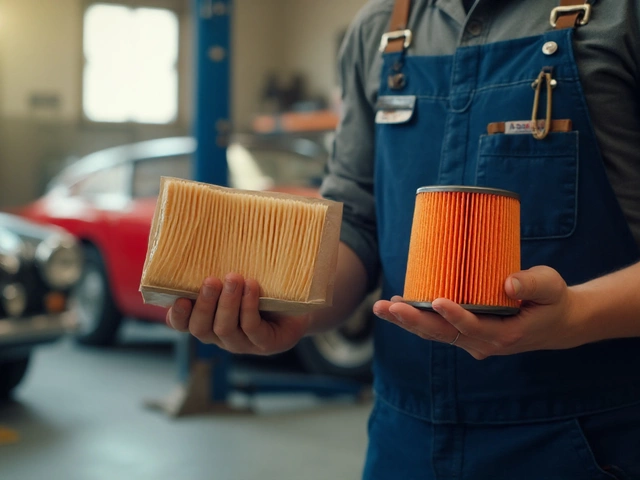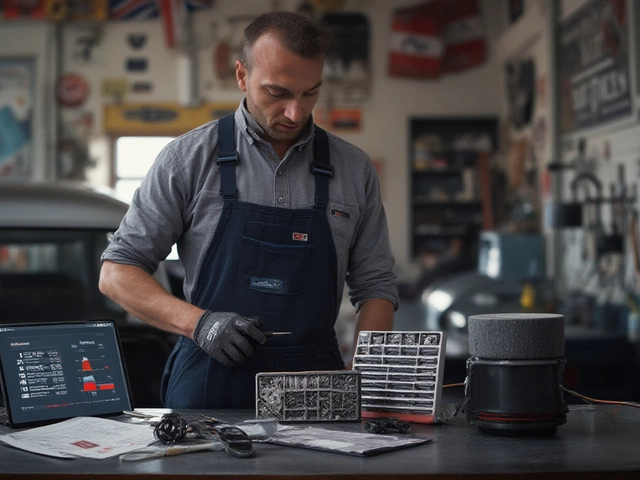Thinking about swapping out your regular air filter for a K&N? It’s a popular move—those bright red filters have been hyped in ads, at car meets, pretty much everywhere people talk performance. But are they really worth it, or just another flashy add-on?
Here's the thing: K&N filters aren't just about making your engine bay look cool. These reusable cotton filters are built to let more air flow to your engine, which (at least on paper) means better throttle response and maybe even a few extra horsepower. But you’re probably wondering—does this actually play out in the real world, or is it just marketing spin?
If you drive often, you’ve probably had to replace your regular filter every year or so. K&N sells you on a 'washable for life' pitch. You clean it, oil it, pop it back in. Over a few years, that sounds like savings. Thing is, there are some trade-offs, and not everybody’s happy when it comes to actual maintenance or possible issues with sensors and warranty.
We’ll weigh these pros and cons with solid details, and flag up some things real K&N users wish they knew before buying. No nonsense—just what matters if you’re thinking about putting one in your car or truck.
- What Makes K&N Filters Special?
- Performance Changes: Hype vs Reality
- Maintenance and Longevity
- Warranty, Cost, and Value
- When (and When Not) to Choose K&N
What Makes K&N Filters Special?
When you think about a K&N filter, the first thing that pops up is that bold claim: more power and better airflow than your boring paper stock filter. But what’s actually different? It comes down to how they’re built and what they’re made of.
Instead of paper, K&N filters use an oiled cotton material layered and sandwiched between wire mesh. The idea is pretty straightforward. The cotton lets more air flow through (which your engine loves) while the oil traps dirt before it gets sucked into your cylinders. The result? You get less restriction, a unique throaty intake sound, and—if everything works out—a bit more punch when you hit the gas.
There’s also the whole 'washable and reusable' hook. Unlike regular throwaway filters, a K&N can last up to 10 years or a million miles if you take care of it. The company is so confident that they back it with a 10-year/million-mile limited warranty. That's pretty wild compared to swapping paper filters every 12,000 to 15,000 miles.
It’s not just all marketing fluff either. Car and Driver ran some tests and said:
"On average, we saw a 1 to 2 horsepower increase with a performance air filter like K&N over the stock filter. It’s not huge, but it’s measurable."
You might be thinking—well, that doesn’t sound like much. True. But for some folks, every little bit counts, and the reusable angle is a legit money-saver over time.
Just to give you an idea, check out this simple table comparing basics of a K&N filter and a standard paper filter:
| Feature | K&N Filter | Paper Filter |
|---|---|---|
| Material | Oiled Cotton | Pleated Paper |
| Service Life | Up to 10 years | 12,000–15,000 miles |
| Reusability | Washable & Reusable | Disposable |
| Airflow | Higher | Standard |
| Initial Cost | Higher | Lower |
If you want to switch, you don’t need to mod anything else. Pop it into your stock airbox, and you’re good to go. Maintenance is easy but necessary—just wash, dry, and oil it when it looks dirty. This makes K&N filter a favorite in the performance air filter world, especially for folks who don’t mind getting their hands a little messy from time to time.
Performance Changes: Hype vs Reality
Every car forum has at least one thread claiming K&N filters add instant horsepower and drop your 0-60 times. But is it really that dramatic? Here’s what actually happens when you replace your stock filter with a K&N filter.
Engineers measure intake air flow and resistance, and paper filters are designed to catch dust well but can become restrictive, especially if they get dirty. Performance air filters like K&N use layers of oiled cotton, letting more air get through. More air means the engine can mix in more fuel–in theory, that gives a mild bump in power.
But let’s get real: Unless your car has a turbo or a big V8 that’s really air-hungry or your old filter is totally clogged, don’t expect to feel a huge difference. Most stock engines see a boost of about 1-4 extra horsepower, and only on wide open throttle. You probably won’t notice this on the daily drive, but on a dyno, it’s measurable. Here’s a quick look based on a few real-world dyno runs:
| Car Model | Stock Filter HP | K&N Filter HP | Actual Gain |
|---|---|---|---|
| 2019 Civic 2.0L | 146 | 149 | +3 |
| 2020 Mustang GT | 444 | 448 | +4 |
| 2018 Tacoma 3.5L | 275 | 277 | +2 |
There’s also a sound upgrade. Most people notice a slightly throatier sound under acceleration. It won't turn your Honda into a muscle car, but you’ll hear a bit more intake noise.
Here’s the catch: if your car’s computer can't adjust for extra air (older cars or non-adaptive ECUs), those gains may be less or even nonexistent. Also, modern engines tune themselves pretty quickly, so if it did feel quicker on day one, that turbocharged performance might disappear after a few drives.
Biggest takeaway? If your main goal is a big jump in horsepower, a K&N filter on a stock engine is more about small tweaks than game-changing speed. But if you like a bit more sound and maybe a tiny edge, it’s a simple upgrade.

Maintenance and Longevity
Here’s the honest deal with K&N filter maintenance: if you’re used to ordinary throwaway paper filters, you might be expecting the same no-fuss routine. That’s not really how it works. K&N filters are built to last years—sometimes the entire life of your car—but you do need to give them some attention a couple times a year, depending on where and how you drive.
The cleaning process isn’t rocket science but it’s more involved than just tossing out the old and sliding in a new one. You’ll need a special K&N cleaning kit, which costs about $15–$20. Here’s what goes down:
- Take the filter out of your airbox (not tough, but watch for stiff clips).
- Spray it down with the K&N cleaner and let it soak for 10 minutes to loosen dirt.
- Rinse from the clean side out—never the dirty side in—so you don’t push gunk deeper.
- Let it dry completely. Do not ever use a hair dryer or put it in the sun to speed this up, or you risk messing up the cotton material.
- Oil it evenly using the K&N oil from the kit—don’t drown it, but don’t underdo it. Too much or too little oil can cause issues, especially with airflow sensors.
This all takes about an hour from pulling the filter out to putting it back in. If you ignore the cleaning or mess up with the oil, you risk dirt sneaking by or your car performance dropping. Some folks have dealt with oil getting on their mass airflow sensor (MAF)—which can mess up your engine readings and trigger warning lights—because they over-oiled it. So, a steady hand helps.
If you drive in dusty areas or you’re always in stop-and-go city traffic, you’ll probably need to clean the filter more often, maybe every 10,000–15,000 miles. If you’re a highway cruiser in gentler conditions, K&N themselves say you can stretch it to around 50,000 miles. That’s a big range, so check it once in a while.
Here’s a quick snapshot comparing a regular paper air filter against a K&N:
| Filter Type | Lifespan | Maintenance | Cost Over 5 Years |
|---|---|---|---|
| Paper Filter | 12,000 - 15,000 miles | Replace each time | $60 - $100 |
| K&N Filter | Up to 1,000,000 miles | Clean and re-oil | $60 (one-time plus cleansing kit) |
One cool advantage: K&N filters are way greener since you aren’t tossing filters in the trash every year. But if you don’t want to play chemist with cleaning kits and oil, you might get annoyed. On the upside, proper upkeep means you should never need to buy a filter again—and there are drivers out there still rocking their original K&N after 200,000+ miles.
Warranty, Cost, and Value
Let’s break it down: The price tag on a K&N filter is way higher than what you pay for a factory paper filter. You’ll often see a K&N going for $50-$80, while a regular filter might hit you for $10-$20. That’s a big jump, no way around it. But remember—K&N filters are designed to be cleaned and reused, not tossed out every time you do your oil change.
Cost is just one piece of the puzzle. K&N filters do come with a super-long warranty. We’re talking 'Million Mile Limited Warranty.' If you have the car long enough, you might never need to buy another air filter again. Sounds awesome, but there’s a catch: you need to follow the cleaning and re-oiling routine, or you risk problems—either with the filter’s performance, or even voiding that warranty. Forget to use K&N's own cleaning kit, and support might not help if something goes wrong.
Car warranty worries? Some dealerships might tell you a K&N filter will mess up your vehicle warranty, especially if you’ve got a newer ride. Usually, the law says a dealer needs to prove a part caused the problem, but some folks have had headaches getting warranty work done after switching to a performance air filter. Mass airflow sensors, in particular, are sensitive to oil from reusable filters if you go overboard during maintenance. If you stick to K&N’s instructions, you’ll usually be fine, but it’s something to keep in mind.
Is it a good value? If you plan to keep your car for years and you don’t mind doing a bit of cleaning instead of swapping out filters, you’ll probably save money in the long run. If you’re trading cars every couple of years or hate the idea of washing and oiling an air filter, all that upfront cost might not make sense.
| Air Filter Type | Upfront Cost | Replacement Interval | Annual Cost (Average) |
|---|---|---|---|
| K&N Filter | $60 | Clean every 50,000 miles (recommended) | $12 (assuming 5 years) |
| OEM Paper Filter | $15 | Replace every 12,000-15,000 miles | $30 (assuming two changes/year) |
So, do the math for your own situation. Long term, K&N filters can pay off, but only if you actually keep up with the cleaning and stick with the same car. Otherwise, it might just be an expensive gadget sitting under your hood.

When (and When Not) to Choose K&N
So, is a K&N filter the right fit for your ride? Let’s break this down into real-world situations, because not every engine (or driver) benefits the same way.
When a K&N filter makes sense:
- You do a lot of driving—think high-mileage commutes, road trips, or delivery jobs. The washable, reusable design keeps more money in your pocket long-term instead of swapping out paper filters every year.
- Your car or truck has mild bolt-on mods, like an aftermarket exhaust or intake. Here, a K&N filter might help you squeeze out a little more airflow for a modest bump in torque or throttle response.
- You’re looking for a filter that lasts. K&N’s warranty says their filters can go up to 1 million miles with proper cleaning. That’s basically the life of your car, if not longer.
- Live in an area with good air quality and don’t do serious off-roading or rally action. Less dust and grit means less risk of filter oil messing with your MAF sensor or dirt sneaking through.
When you might want to skip K&N:
- Your car is still under a strict manufacturer’s warranty, especially turbo or luxury models. Dealers sometimes blame oil from reusable air filters for MAF sensor failures. This can get sticky if you’re trying to make a warranty claim.
- You never plan to clean or re-oil the filter yourself. Yes, K&N filters can last forever—but only if you do the maintenance. Skip it, and you could end up with worse airflow than a basic paper filter.
- If you often drive in dusty or sandy places—construction sites, dirt roads, desert highways—a regular paper or foam filter might catch finer particles and protect your engine better. Some independent tests have shown K&N filters let a bit more dirt through compared to stock filters, especially when cleaned or oiled the wrong way.
- You’re hoping for a big horsepower gain. On most daily drivers, the boost is small—sometimes just 1-3 HP, which you probably won’t feel unless you’re drag racing for tenths of a second.
Want a quick comparison? The table below sums up when a performance air filter like K&N stands out versus when a regular filter might be better.
| Scenario | K&N Filter | Stock Air Filter |
|---|---|---|
| High-mileage daily driver | Great money-saver | Costs add up |
| Warranty concerns | Possible issues | Safe bet |
| Dusty/sandy roads | Riskier | Better protection |
| Performance gains | Mostly minor | No change |
Bottom line—know your driving habits, your car’s needs, and how willing you are to get your hands dirty. If easy maintenance and a tiny power bump sound good, a K&N filter makes sense. Otherwise, stick to a solid stock filter and change it out regularly.




